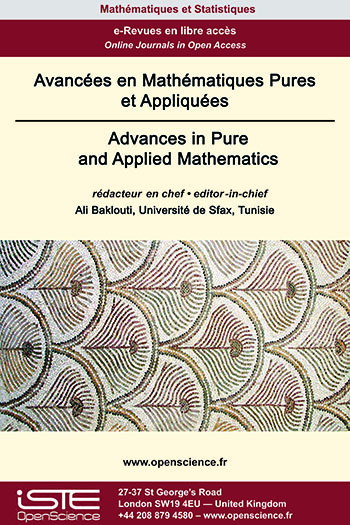

Mathematics > Home > Advances in Pure and Applied Mathematics > Issue
This paper is devoted to the study of the nonhomogeneous problem
$$$
-div (a(|\nabla u|)\nabla u)+a(| u|)u=\lambda V(x)|u|^{m(x)-2}u-\mu g(x,u) \mbox{ in} \ \Omega, \ u=0 \mbox{ on} \ \partial\Omega ,$$$ where $$$\Omega$$$ is a bounded smooth domain in $$$\mathbb{R}^N,\lambda, \mu$$$ are positive real numbers, $$$V(x)$$$ is a potential, $$$ m: \overline{ \Omega} \to (1, \infty)$$$ is a continuous function, $$$a$$$ is mapping such that $$$ \varphi(|t|)t$$$ is increasing homeomorphism from ℝ to ℝ and $$$g: \overline{\Omega}\times ℝ \to ℝ$$$ is a continuous function. We establish there main results with various assumptions, the first one asserts that any $$$\lambda$$$0> is an eigenvalue of our problem. The second Theorem states the existence of a constant $$$\lambda^{*}$$$ such that every $$$\lambda \in (0,\lambda^{*})$$$ is an eigenvalue of the problem. While the third Theorem claims the existence of a constant $$$\lambda^{**}$$$ such that every $$$\lambda \in [\lambda^{**},\infty)$$$ is an eigenvalue of the problem. Our approach relies on adequate variational methods in Orlicz-Sobolev spaces.
In this work we establish a general decay rate for a nonlinear viscoelastic wave equation with boundary dissipation where the relaxation function satisfies $$$g^{\prime }\left( t\right) \leq -\xi \left( t\right) g^{p} % \left( t\right) , t\geq 0, 1\leq p\leq \frac{3}{2}.$$$ This work generalizes and improves earlier results in the literature.
In this paper, we consider the following inhomogeneous nonlinear Schrödinger equation (INLS)
$$$i\partial_t u + \Delta u + \mu$$$ |$$$x$$$|$$$^{-b}$$$|$$$u$$$|$$$^\alpha u = 0, \quad (t,x)\in ℝ \times ℝ^d$$$
with $$$b, \alpha$$$ > 0. First, we revisit the local well-posedness in $$$H^1(ℝ^d)$$$ for (INLS) of Guzmán [Nonlinear Anal. Real World Appl. 37 (2017), 249-286] and give an improvement of this result in the two and three spatial dimensional cases. Second, we study the decay of global solutions for the defocusing (INLS), i.e. $$$\mu=-1$$$ when 0 < $$$\alpha$$$ < $$$\alpha^\star$$$ where $$$\alpha^\star = \frac{4-2b}{d-2}$$$ for $$$d\geq 3$$$, and $$$\alpha^\star = \infty$$$ for $$$d=1, 2$$$
by assuming that the initial data belongs to the weighted $$$L^2$$$ space $$$\Sigma =\{u \in H^1(ℝ^d) :$$$ |$$$x$$$|$$$ u \in L^2(ℝ^d) \}$$$. Finally, we combine the local theory and the decaying property to show the scattering in $$$\Sigma$$$ for the defocusing (INLS) in the case $$$\alpha_\star$$$ < $$$\alpha$$$ < $$$\alpha^\star$$$, where $$$\alpha_\star = \frac{4-2b}{d}$$$.
This article concerns the discrete-time problem of the damped Schrödinger equation in a bounded domain and the internal stabilization problem is considered. We constructed a well-posed discrete-time scheme and we proved the exponential stability. Numerical simulations are presented to illustrate the theoretical results.

2025
Volume 25- 16
Issue 1 (January 2025)2024
Volume 24- 15
Issue 1 (January 2024)2023
Volume 23- 14
Issue 1 (January 2023)2022
Volume 22- 13
Issue 1 (January 2022)2021
Volume 21- 12
Issue 3 (Special AUS-ICMS 2020)2020
Volume 20- 11
Issue 1 (May 2020)